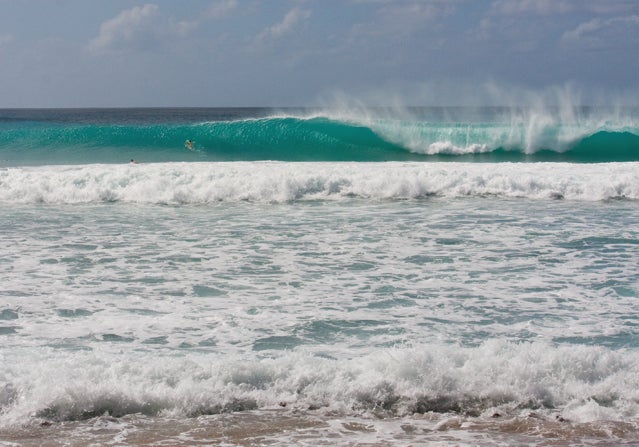
Beach hazards abound. Your surfboard can knock you out. Corals might scrape your face off. A shark could mistake you for a seal or, more likely, you might bump into a jellyfish. Those are risks most of us willingly accept. But when you leave the beach vomiting, or with diarrhea or a fever due to fecal matter in the water, that's just not cool.
On Monday, the Environmental Protection Agency (EPA) finalized its standards for recommended recreational water quality criteria—basically, the levels of water pollutants (like fecal-linked enterococcus in coastal waters and E. coli for the Great Lakes) above which it thinks states or municipalities ought to close public beaches due to hazards to public health. But the new recommendations are weak, says the (NRDC) as well as the Surfrider Foundation, because they are voluntary and offer multiple levels of standards.
The two main recommendations are set to levels of the bacterial pollutants, based on water samples, that could make 32-36 out of 1,000 beachgoers ill. But the EPA offered two even stricter (much stricter) water quality level alerts, called Beach Action Values, and is giving municipalities real incentives to opt for those—aside from a wish to better protect human health.
But, incentives or no, municipalities generally push to keep beaches open as long as possible to ensure a
steady stream of beachgoers and a strong local economy (remember Jaws?), says Mara Dias,
water quality manager for the Surfrider Foundation.
“I find it hard to envision a circumstance where a state would use the
most restrictive [level],” she says.
States can either do nothing (stick with existing guidelines) or choose from the four new options. “So while there is the opportunity for these new criteria to be applied in a way that would be more protective of public health,” Dias says, “by giving five different choices for beach decisions to be made, I think the EPA has more muddied the water than clarified it.”
Since the EPA does not have authority to close or open individual beaches, it's up to the states to decide on and enact water quality standards for its beaches, and in some large states, that authority is handed down to the county. And not all states follow EPA guidelines uniformly.
“There are some inconsistencies across the country,” says Steve Fleischli, who directs the NRDC's water program. “That is part of the reason we wanted new criteria. But unfortunately this does not resolve that issue. It still lends itself to inconsistency.”
States do need to comply with EPA recommendations in order to keep receiving grant money that they use to enforce the water quality programs and fund testing programs, but that funding is quite vulnerable to budget cuts, says Dias. She says the funding has been spared the axe for now, but it's an ongoing concern.
On the bright side, the EPA criteria also endorse the use of a water testing method, called Quantitative Polymerase Chain Reaction (qPCR), which is significantly faster than older, culture-based tests, which can take 24 hours to show results.
Fleischli points out that while qPCR is a costlier method than existing tests, those costs will come down if it becomes a more popular approach. Plus, accessing results more quickly means taking action more quickly to close a beach, and therefore reduces the chance of beachgoers getting ill. The faster tests will also allow officials to open up beaches more quickly, which local business owners will appreciate. Fleischli says beachgoers can and should tell local and state officials that they want the more protective standards chosen. “I think that's a really important message,” he says.
You can also check out the and the , each of which have member-based monitoring programs that empower recreationalists to report poor water quality.
THE BIGGER PICTURE
States could test water day in and day out, but unless the sources for pollution are addressed, nothing will change.
“The biggest concern here with water quality on the coast is
stormwater pollution,” says Brett Walton, a reporter for , a news site focused on global water issues. While it's hard to track specific water pollution instances to their source, runoff from storms and sewage system overflows are major contributors. Given that, controlling the amount of polluted runoff, in urban areas
in particular, is the first line of defense.
Cities, notably Milwaukee and Philadelphia, Walton says, are rising to the challenge by developing green infrastructure such as permeable surfaces as a means of preventing polluted runoff from entering major water sources in the first place. “By going back to natural systems to regulate flow, you don’t have a surge of dirty runoff flowing into the water after a storm.”
—Mary Catherine O'Connor